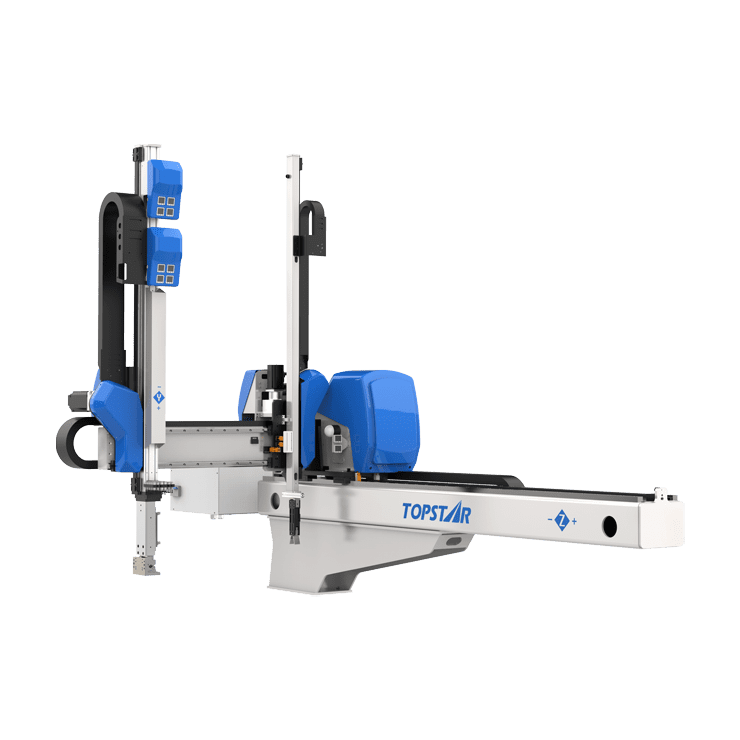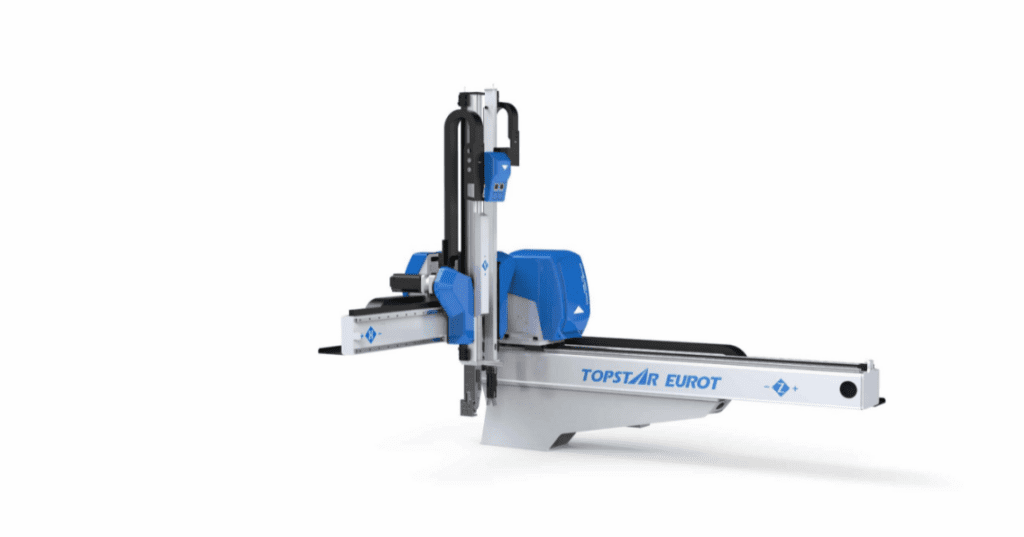How does injection machine robot help industry?
2022/04/29 By 兰兹

What are industrial robots?
An injection machine robot is one of the most used tools in process automation. A robot is a programmable manipulator with several axes (between 3 and 6). It is designed to automate industrial processes that are repetitive or require a lot of effort.

Critical advantages of robotics to automate your manufacturing
- They do not rest, which makes them more productive than a human.
- They free humans from repetitive, tedious, or non-ergonomic tasks.
- The injection machine robot doesn’t make mistakes. The repetitiveness of its movements is high and precise.
With them, quality, productivity, and profitability are achieved. For this reason, industrial robotics has become a key element in process automation. The primary industry that installs these robots is the automotive industry.
Although we can already see them in many sectors such as food, household appliances, kitchenware, packaging, plastic injection…
Tips for installing an industrial robot
When installing the best industrial or collaborative injection machine robot, you must look at different parameters. It is always appropriate to seek advice from automation experts or technicians from other robotics brands.
Speed: The cycle time will mark our need. Given the application, we may prefer to choose robots with fewer axes, which are much faster when handling parts.
Protection level: Depending on the environment where the injection machine robot will be installed, you need some IP protection. The degree of security will be determined by the industry: food,
The three essential parameters when thinking about buying a robot are
Process: It is the main reason to install a robot and, therefore, the most important a priori. Depending on how the process is carried out, choosing a robot with a greater or lesser number of axes will be better. Everything will depend on the complexity of the movements.
It will also help us discern between industrial or collaborative robots and the level of security required.
Force: The load that the injection machine robot will have to handle will define the suitable model. When buying an industrial robot, we must consider the payload (maximum load).
Scope: It is necessary to know, depending on the application, what the distance of the operation is. Therefore, we must focus on the maximum operating range, which adjusts to our needs.
Pharmaceutical products, medicines, hospital, and surgical products; by application; flammable environments, humid environments, paint…
Operations performed by a robot in plastic injection
Inspection: Using peripheral equipment such as artificial vision, the injection machine robot can move the piece for its positioning or impact the inspection equipment. As well as feeding and unloading the test bench automatically.
Unloading: This technology consolidates in the sector for unloading injectors. Mainly its use of Cartesian robots, although in recent years, the demand for anthropomorphic robots has grown due to their versatility.
Placement of inserts in the mold: Specific components must be introduced into the mold of the injector and thus be integrated into the part. In this operation, six-axis injection machine robots that have greater mobility and allow inserting more complex inserts from the side of the fuel transfer machine are beneficial.
Cutting and deburring through using blades
Casting cutting is the same robot that extracts the piece using blades or pneumatic pliers. Likewise, a robot can debit the parts, although in this case, we recommend investing in improving or repairing the molds to reduce these failures.
Since the burrs tend to vary in size or position and complicate or make the process more expensive, to remove them.
Handling: Injection machine robots do the most common operation. The movements of parts are between stations or machines.
Packing: for all the subjects of packaging and palletizing at the end of the line.

Injection molding with robots
Currently, the collaborative robotics market has high growth prospects in many industrial and non-industrial sectors.
In particular, in the world of plastics, according to BIS Research, 15% of all cobot applications in 2020 were dedicated to the assistance of injection molding machines.
These injection machine robots have the freedom of movement of an industrial robot. But they favor the possibility of working close to humans. With a risk assessment and the correct security integration, a robot will assist human operators in your factory without fencing.
In conclusion, this translates into the possibility of automating processes that could not be done before and saving space in the plant.
Safety measures for a robot with an injection molding machine.
According to the manufacturers, these injection machine robots are designed to work hand in hand with humans, as if they were another partner but quieter. We, as integrative engineers, prefer to carry out a study of the process to be carried out.
The robot can be collaborative, but not the app. For this reason, in 90% of the projects we find, security devices must be installed to comply with regulations and the internal security protocols of each factory.
With a presence scanner and through programming, it is possible to determine areas with different speeds. It is also visually pleasing since there are no large fences.
Automation is a technological tool to boost the productivity and efficiency of the injection machine robot. Therefore, reduces costs and makes companies more competitive. In addition, it makes it more flexible through adaptability and simple reconfiguration in the face of new economic paradigms.
Advantages of automation
Covid-19 has had not only unfortunate health effects on the population but also on social ones, causing the modification of some of our habits, forms of behavior, and interactions between people.
To all this, we must add the shock caused in the economy, where GDP has declined, and the production of many factories has had to stop due to confinement.
Thus, injection machine robots adapt to demand, prioritizing low prices as an essential variable when buying.
Automation is not an expense!
Therefore, automation will be a pillar of technological transformation in the new paradigm that presents to us at the production level, business management, and marketing.
It is an investment. Investment in technology, especially automation, has direct effects and increases efficiency, productivity, profitability, and profit.
Private companies that invest in innovation and automation in their service and production areas show faster financial recovery and greater flexibility to adapt to new economic plans.
TRENDING POSTS
HOT TOPIC
- Air Chillers
- AP-RubberPlas
- Automation changed engineering
- automation of injection molding robots
- Bench Injection Molding Machine
- Cabinet dryer manufacturers
- Cabinet dryers
- CNC Drilling Machine
- CNC Drilling Machines
- cnc engraving machine manufacturer
- cnc laser cutting machine manufacturer
- CNC Machine for Sale
- CNC Machine Manufacturing
- CNC Machine Tool
- CNC machine tool product
- CNC Machining Center
- CNC wood carving machine
- Cooling system
- Cross-Walking Single Axis Servo Cylinder Robot
- Cross-Walking Single-Axis Servo Cylinder Robot
- Cross-Walking Three-Axis/Five-Axis Servo Driven Robot
- cross-walking three-axis/five-axis servo-driven robot
- Dehumidifier Dryer
- delta parallel robot
- Desktop Injection Molding Machine
- Desktop injection molding machines
- Desktop Molding Machine
- Desktop Plastic Injection Molding Machine
- direct clamp injection molding machine
- Direct clamp injection molding machines
- Dosing & mixing system
- Drilling Centers
- Drying and dehumidification system
- drying and dehumidifying equipment
- Drying and Dehumidifying System
- drying system
- effective and efficient. Cabinet dryers are also used in other industries where large quantities of material need to be dried
- elbow hydraulic injection molding machines
- Feeding And Conveying System
- Five Axis Machine Center
- GMU-600 5-Axis Machining Center
- Granulating & Recycling System
- Honeycomb rotor dehumidifier
- horizontal injection molding machine
- Horizontal Injection Molding Machines
- Horizontal Injection Moulding Machine
- Horizontal Mixer manufacturer
- How The CNC Machine Works
- Industrial robot
- industrial robot parts
- industrial robot supplier
- Industrial robots
- Industry Chain
- Injection Manipulator
- Injection molding
- Injection molding automation
- Injection Molding Automation Solution
- Injection molding machine
- Injection Molding Machine Factory
- Injection Molding Machine Manufacture
- Injection molding machine procurement
- injection molding machine with a robot
- Injection molding machines
- injection molding plant
- Injection molding robot automation
- Injection Moulding Robots
- Injection Robot
- Injection robot arm
- Introducing Injection Robot
- It is the best choice for drying large quantities of material at once. Cabinetmakers use these machines because they are fast
- large injection molding machine
- Learn what industrial automation and robotics is
- low speed sound-proof granulator
- machine plastic molding
- make sure to add some! Improvements (2) Keyphrase in introduction: Your keyphrase or its synonyms appear in the first paragraph of the copy
- manufacturing
- micro injection molding machine
- middle speed granulator
- Mini CNC machine manufacturers.
- Mold Temperature Control System
- molding material Dehumidifying System
- New electric injection molding machine
- nitrogen dryer manufacturer
- nitrogen dryer system manufacturer
- Oil type mold temperature controller
- Outbound links: No outbound links appear in this page. Add some! Images: No images appear on this page. Add some! Internal links: No internal links appear in this page
- plastic forming equipment
- plastic injection machine
- plastic injection molding
- Plastic injection molding machine
- Plastic Injection Molding Machines
- plastic injection robot
- plastic molding press
- plastic-molding machine
- powerful granulator
- Powerful Type Sound-Proof Granulator
- production of plastic seats
- robot injection molding machine
- robot manufacturing companies
- Robotic arm for injection molding machine
- robotic injection molding machines
- robotics in injection molding
- SCARA robot
- Service-oriented manufacturing
- Servo Cylinder Robot
- servo driven robot
- Servo Driven Robots
- servo injection robots
- Servo-Driven Robot
- Setup of injection machine
- Silicone Injection Molding Machine
- six-axis industrial robot
- Stainless Hopper Dryer
- swing arm robot
- toggle clamp injection molding machine
- Topstar
- Topstar Engineering
- Topstar injection molding intelligent
- Topstar Scara Robots
- Useful Injection molding machine
- Vertical machining centers
- volumetric type blender
- water distributor
- x carve CNC
